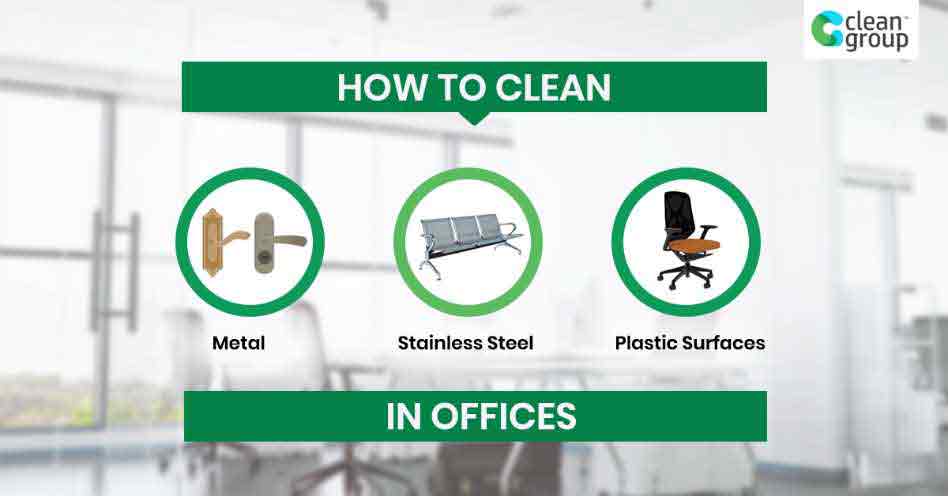The kitchen is almost always present in the office. Here, you can find appliances that are made out of different materials and surfaces. Ever wonder how your office cleaning makes this appliance sparkle and shines like new?
Professional hygienic surfaces touchpoint cleaners have complete knowledge in metal disinfection and stainless steel cleaning. In this article, we will share with you how our cleaners cover different surfaces like plastic, metal, and stainless steel.
Why hire a professional cleaner to take care of different surfaces? Because they are a pro. It is about time for you to shop around and give your office the cleaning it deserves. Click this link to know which questions to ask from an office cleaning Sydney company. They will know all the best practices on how to take care of you, your employees, and everything that is inside your office.
You may want to review the do’s and don’ts on metal and stainless steel cleaning if you venture with manufacturing companies. Most of their surfaces are made out of these materials.
It is useful to equip yourself with knowledge on how you will clean these not only to offer a workplace that is pleasing to the eye but also helping your client extend the life of these surfaces.
Metal Cleaning
For general polishing, you will be surprised to come across something as simple as water. Water can be used in cleaning metal, but you need to pair it up with a good microfibre cloth.
All you need to do is to fill a spray bottle with tap water and spray the surface a liberal amount on the metal surface. Once done, get the microfibre cloth and wipe the water on the surface from left to right to get rid of the dirt and dust that were seated on the surface.
Using a dry and disinfect microfibre cloth, dry the surface and make sure that you get rid of any moist spots as moisture can attract rust in the future.
Always read labels when it comes to cleaning metal surfaces because metals can be sensitive to cleaning materials. You need to be sure that you are using a non-corrosive chemical to prevent rusting.
How to Clean Stainless Steel Surfaces and Kitchen Appliances
Stainless Steel and Metal materials and surfaces are beautiful to look at, but they can catch dirt and dust easily. It tends to get greasy and full of fingerprints.
Have you ever thought about why stainless steel is called stainless steel when all it does is attract stain? First and foremost, let us talk about what stainless steel is made out of. Stainless steel became a trend not only because it looks great, but because of its anti-corrosive properties, meaning, it is durable and is a safe choice for food preparation. Restaurant kitchens are full of stainless steel.
Stainless Steel is made from chromium which explains why stainless steel is stainless. It forms a chromium oxide that creates a protective film on the steel. That prevents staining and corrosion.
Stainless Steel No No
How many people do you know that know stainless steel has a grain to it? The grain is something fundamental that you need to consider before cleaning any stainless steel surface or appliance. You cannot use anything on it that can be regarded as abrasive.
This encompasses all the cleaning products that have any kind of abrasiveness to them. Some cleaning products are good on the surface but leave a residue that will attract other dirt. With stainless steel, microfibre towels are the best.
- Do not use any abrasive sponges, steel wool, or anything that has a rough surface in cleaning the stainless steel surface. You can scratch the surface and repair can be expensive, timely, and very annoying.
- You cannot use chlorine bleach in cleaning any stainless steel surface. This type of material is sensitive to it and will damage the finish
- Do not clean in circles or against the metal grain. You will be cleaning forever, and if you clean against the grain, you can damage the finish.
- Do not let dirt, grime, dust, and cleaning solutions sit on the surface for too long. It can ruin the finish. Get rid of all residues with a disinfect cloth as soon as possible.
- Do not expect the stainless steel surfaces or appliances to self-shine. You need to get all of the cleaning products or dirt off of the finish and buff it dry with a perfectly clean cloth.
- Always use a fresh and clean microfibre towel when cleaning stainless steel surfaces and appliances.
- When you wipe, it does not need to be hard. Just put the right amount of pressure when wiping the surface.
- Do not use ammonia-based cleaner because it is potentially a corrosive chemical. It cannot ruin the surface on the first go, but over time, it can knock off the finish of the stainless steel surface.
There are a lot of ways to disinfect your stainless steel properly, and there are a lot of products that you can spend your money on to get it clean and sparkling.
Steps in Cleaning Stainless Steel Surface or Appliance
Let us show you how we, as professional commercial cleaners, handle different surfaces. In stainless steel surface you will need:
– 2 microfibre cloths. A wet one and a dry one when to buff.
– Dish soap which you need to add to hot water
– Paper towel
- Take your microfibre cloth. Run it in water and add the dish soap or your cleaning detergent. Wring it thoroughly and then wipe the stainless steel surfaces following an S-pattern.
- Take the same cloth, rinse it with warm water, and then wipe the stainless steel surface or appliance one more time using the same S-pattern to get the extra cleaning product off.
- Using a dry microfibre cloth, buff the surface. Buffing will eliminate the remaining steaks on the surface.
- You can also shine your stainless steel surfaces and appliances by using rubbing alcohol. It works wonder in stainless tops because it dries super fast and leaves a streak-free finish. One of the additional values of using rubbing alcohol is that it disinfects the surface at the same time.
- If you are working on surfaces that have deeply seated grime, professional cleaners recommend the use of dish soap. Same as how we did with the vinegar and the rubbing alcohol, you can use dish soap in making your cleaning solution. Just mix it with water and put it in a container or a spray bottle.
- Simple water can get rid of most of the marks from your appliances, but if you need something with a little bit more muscles, you can use vinegar. You can substitute this with water. Sometimes, a lot of commercial cleaners use one part of water and one part of vinegar mixed in a container. Spray this straight to the surface to get the desired result. The best part about this vinegar solution is that you can keep it in the fridge which comes in handy in case you need to touch up spills.
Cleaning Plastic Surfaces
Most of the kitchen materials and surfaces that were used in the office are made out of plastics. These surfaces are splatted continuously with food, sauces, and drinks. If they are not regularly wiped over, they will soon begin to look dirty.
In this section, you will need:
- Multi-purpose cleaner
- Double-sided sponge
- Microfibre cloth
- Paper towels
Upper Cabinets
In cleaning upper cabinets, start with the top and work your way down. Spray a little amount of multi-purpose cleaner on the dirty areas. Gently scrub with the abrasive side of the sponge to remove any marks and smudges. Be thorough around the handles as these are where germs can fester.
Remove the cleaning product and then wipe dry with the microfibre cloth. Give the surface a final wipe with the paper towel. This will polish to shine without leaving lint.
Work Surfaces
Spray the multi-purpose cleaner on the work area and scrub the entire surface. Use the other side of the sponge to remove the dirt. Dry it with the microfibre cloth, and then finally buff it with the cleaning towel.
Lower Drawers and Cabinets
Repeat the same pattern to the lower kitchen cabinets. Spray, scrub, wipe, and buff. Pay special attention to the areas which get touched the most and the bottom, which can be often kicked.
As you can clearly see, there are a lot of ways for you to address your dirty surfaces regardless of what material it is made out of. I would love to know which one you like to use. Maybe, you also have one that I did not mention in this article.
Please let us know in the comment box down below. You can also use the same box, so share your cleaning questions, stories, or just to say hello. Again, sharing is caring. There’s a share button down below and if you like this reading material, and find it helpful then let us tell everyone how easy and quick it is to disinfect surfaces with different materials.

